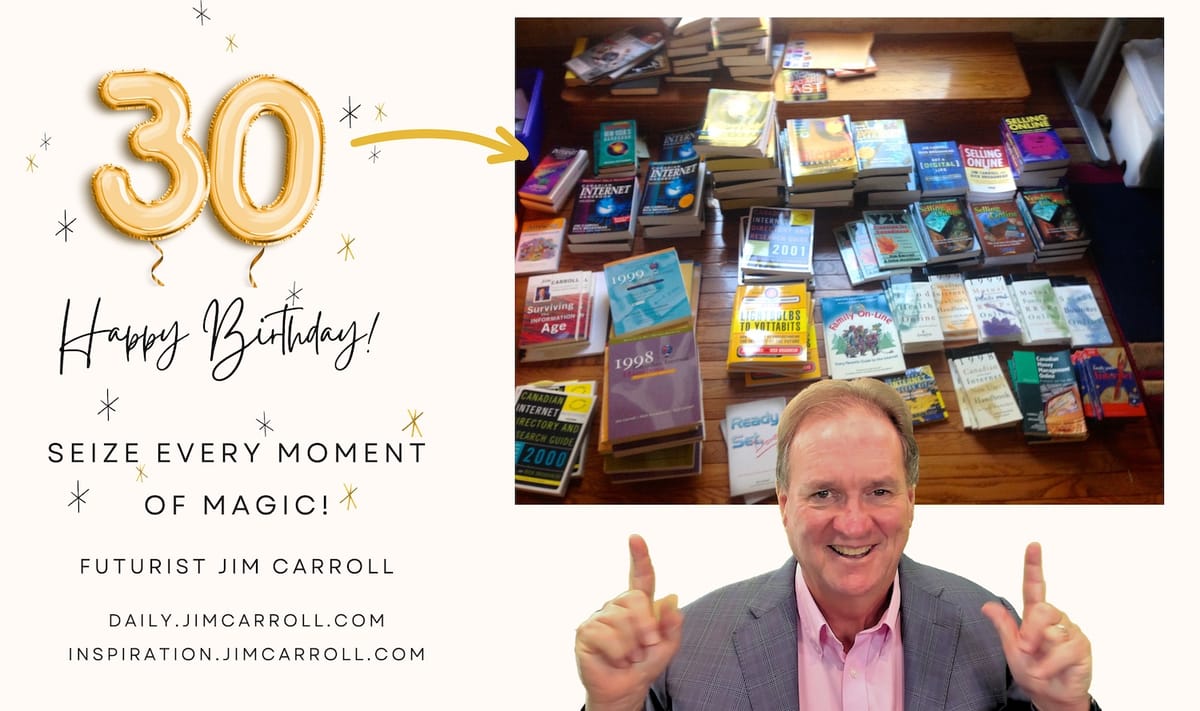"Seize every moment of magic!" - Futurist Jim Carroll
It’s book week! Each day, a post involving one of my books! That’s because there are TWO big milestones this week.
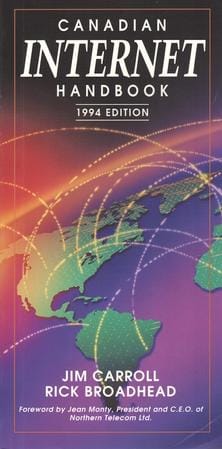
The second one involves the fact that the first edition of the Canadian Internet Handbook launched 30 years ago today!
The arrow in today's inspiration image points directly at the first book of many in a magical voyage in which I found myself in the 90s - the 1994 edition of the Canadian Internet Handbook. Looking back, I've learned that if you ever have the chance to have magic happen in your career, grab it with all you've got and run with it.
It's kind of stunning to think that it was 30 years ago today that the original little book that truly launched my writing and speaking career was published.
Coming in at a mere 140 pages and a 4x9 print format, the book arrived from the printer on March 5, 1994, and the very next day was covered in the Toronto Star. Mere a few weeks later, it entered the national bestseller list - where it hit the #1 spot in June, where stayed for many weeks. By that time, my co-author Rick Broadhead and our publisher knew that we had a wild beast on our hands, and were already writing the 1995 edition of the book, as well as a new side project, The Canadian Internet Directory - essentially, a set of yellow pages about the Internet in Canada.
It wasn't long before our rocket ride took off, and so today is not a marker of just one book - but all the different books that Rick and I took on together through the next seven years - writing 34 titles and selling well over one million copies.
The very next day after the publication of the first book, Rick and I found ourselves and the book profiled in one of Canada's largest newspapers, the Toronto Star. We wore suits to the photo shoot!
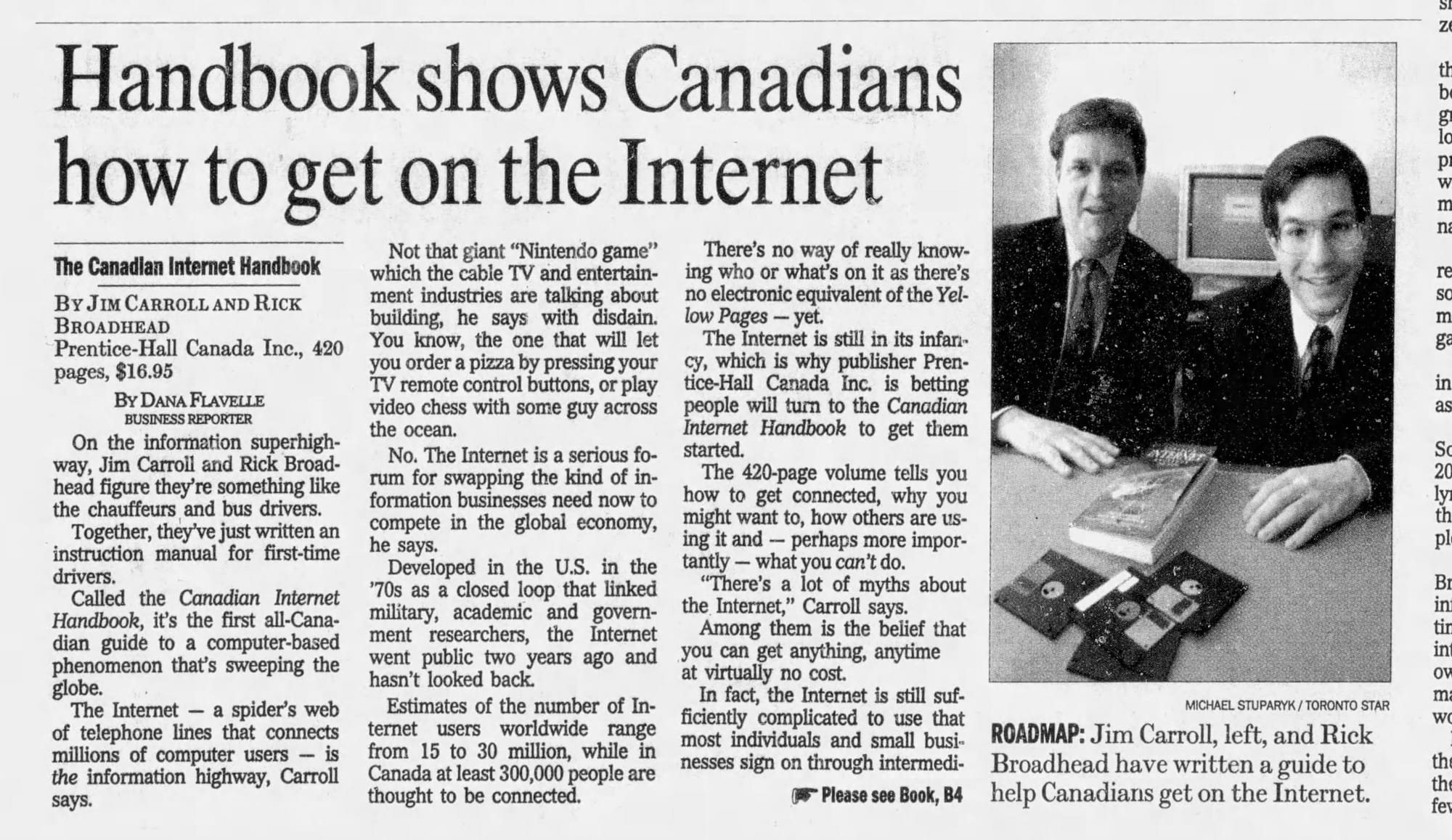
At that moment in time, we had magic happen in our lives, and we ran with it! I often marvel at the sheer number of topics that we tackled, some of which are captured in a photograph I took one day in the home office.

Consider what we put together in a short six years:
- financial planning and wealth management, with two titles - Canadian Money Management Online & a second, two-edition book, RRSP's & Mutual Funds Onlne
- healthcare, and wellness with our groundbreaking book, Good Health Online, much of which predicted where we would find the healthcare system with the arrival of the pandemic some 25 years later
- a business strategy and leadership book, The Canadian Internet Advantage: Opportunities for Business and Other Organizations.
- Selling Online - How to Become a Successful E-Commerce Merchant, a guide to establishing an e-commerce presence on the Internet. The book was released in Canada, the US, and Germany, with a Russian edition falling through at the last minute. VISA found the book to be so compelling that it arranged for a custom edition, placed its logo on the cover, and bought 60,000 copies for distribution. it's not often you get a global organization willing to align its logo with a book!
- The Canadian Internet New Users Handbook, a simple straightforward guide released in 1996 for those who were intimidated by the 800-page Handbook cousin
- the Sympatico Internet Companion, a guidebook given away to those signing up for one of Canada's largest ISPs (Internet Service Providers)
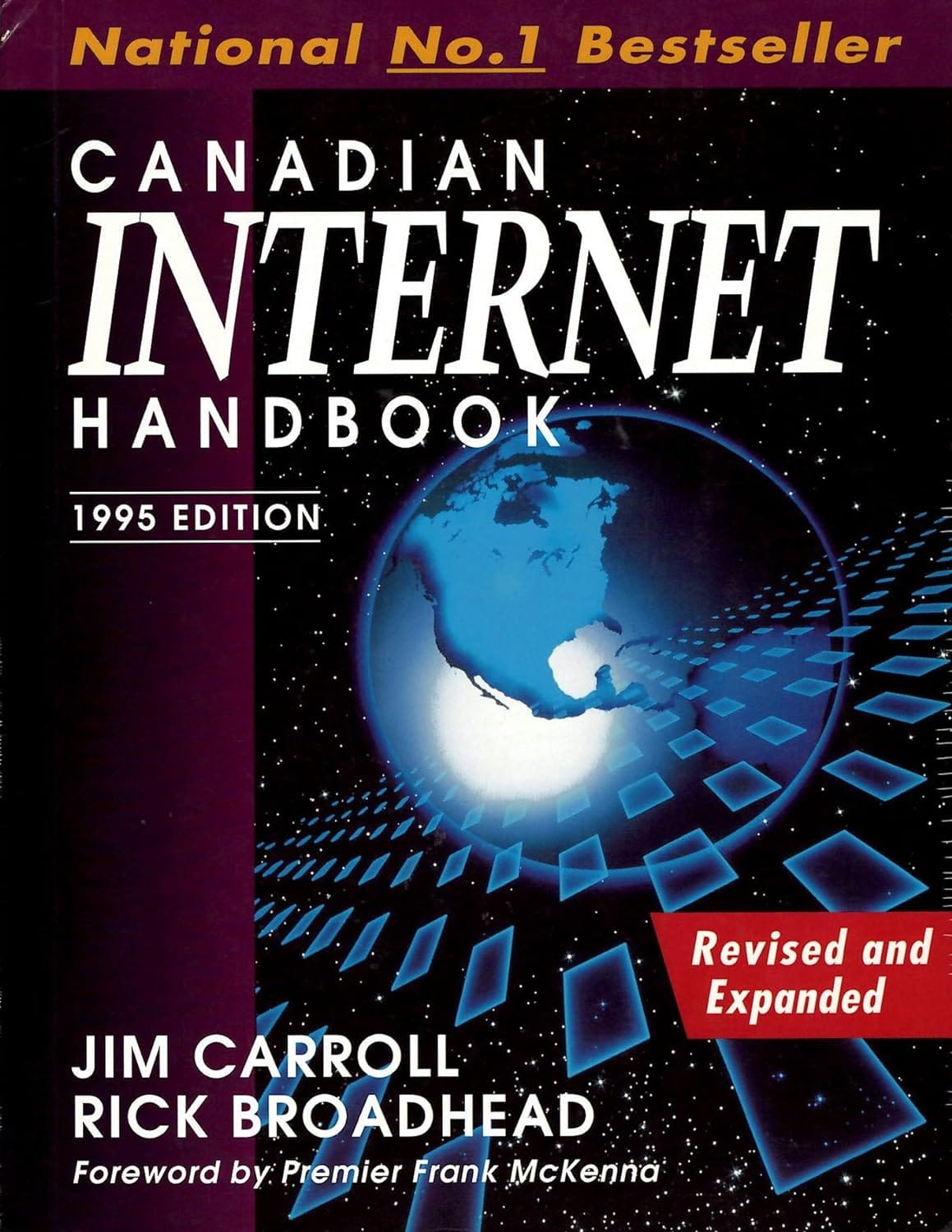
As I will often comment, we had a 'Fifth Beatle" who helped to pull off this remarkable feat - my wife Christa. Behind the scenes, she continually edited and organized our work, rewrote sections written by two computer geeks so that humans could understand them, and often took on a pitched battle with either Rick or me to exclude content that she didn't think made sense, or to add content that she thought should be in a book. She did all this while raising two small babies - at one moment in time, she was editing one of our books less than 48 hours after giving birth to our youngest son, Thomas. I marvel in awe at her abilities to this day.
The mere effort of trying to keep up with the topic was overwhelming as the Internet exploded into the world - and our ability to churn out titles was, in retrospect, pretty overwhelming. In 1996, we released five titles in the space of a few months, responding to the insatiable demand for insight on the topic. During that year, my sons were but 1 and 3 years old; our home was undergoing a massive renovation to build a proper home office for my wife and me; Rick and I launched a national radio show (NetTalk); the speaking circuit had established itself in my life and I was doing 2 or 3 talks a week; and the number of press, radio and TV interviews was, to say the least, pretty demanding. Looking back, I don't know how we did it!
Our publisher at Prentice Hall knew there was an opportunity to be chased in our niche by featuring Canada prominently in the title of many of our works, and that was, to a degree, a marketing ploy. We had some prominent Canadians writing the forward to our book, culminating in 1998 with a foreword by Prime Minister Jean Chretien - such had become our sway in the industry.

That said, our books could hold their own in the breadth of their content in taking on a fast-moving topic. But by 1999, Rick and I knew that we had to branch out with the title of our brand, and so the Canadian Internet Handbook came out under the aegis of two new titles - "From Light Bulbs to Yottabits - How to Profit by Understanding the Internet of the Future" and "Get a (Digital) Life."
And yet, in 2001, we were done, burnt out, finished. Looking back, I'm fascinated we lasted this long. I went on to evolve my role as a futurist; Rick went on to become one of the top literary agents in North America. He and I will, on occasion, jump on a phone call and marvel at the rocket ride in which we found ourselves. We will often look back at this article which appeared 30 years ago tomorrow, and pinch ourselves.
Our lesson is this - if magic happens in our life - run with it as fast as you can!
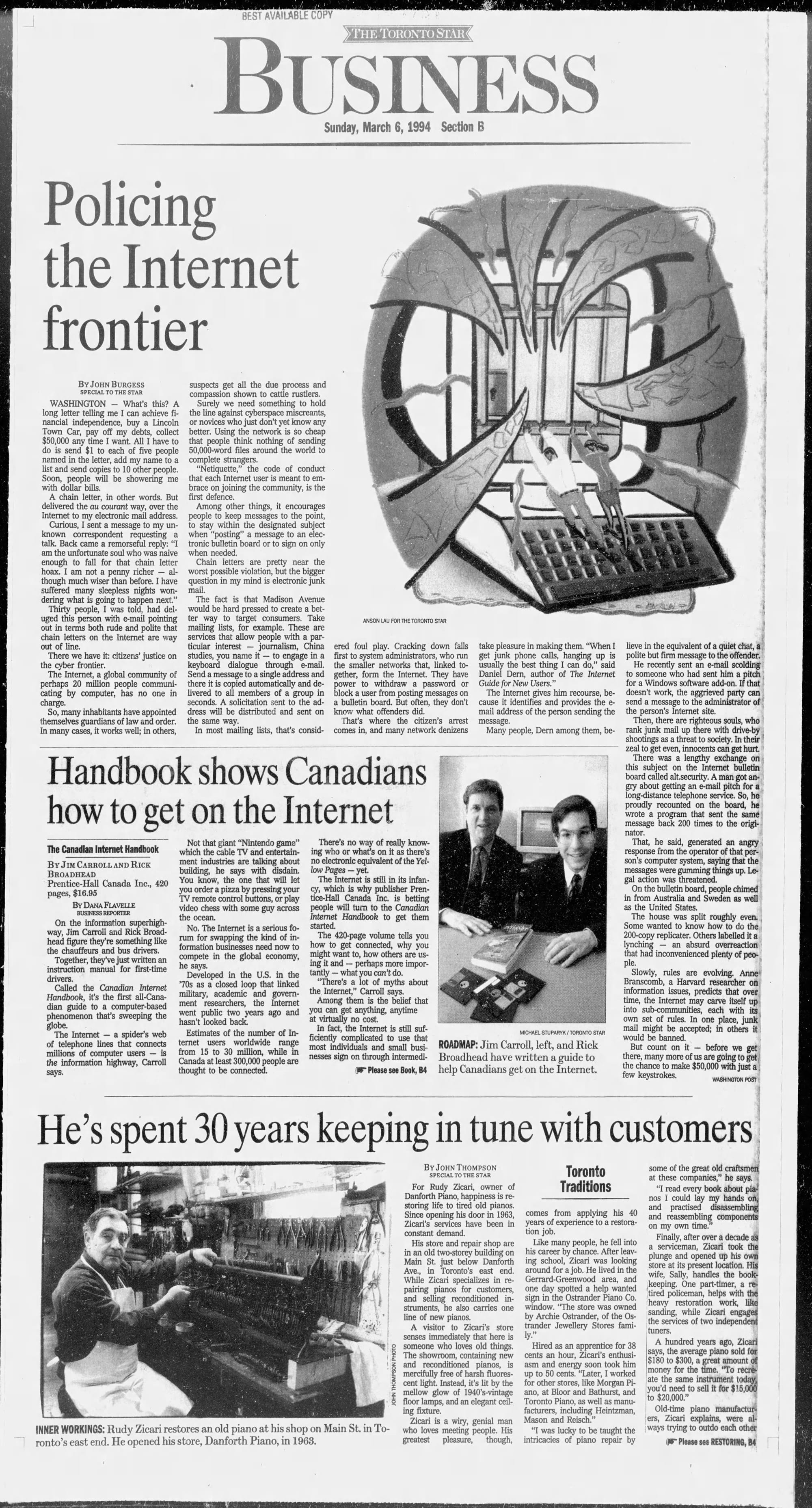
On the information superhighway, Jim Carroll and Rick Broadhead figure they're something like the chauffeurs and bus drivers.
Together, they've just written an instruction manual for first-time drivers.
Called the Canadian Internet Handbook, it's the first all-Canadian guide to a computer-based phenomenon that's sweeping the globe.
The Internet - a spider's web of telephone lines that connects millions of computer users - is the information highway, Carroll says.
Not that giant "Nintendo game" which the cable TV and entertainment industries are talking about building, he says with disdain. You know, the one that will let you order a pizza by pressing your TV remote control buttons, or play video chess with some guy across the ocean.
No. The Internet is a serious forum for swapping the kind of information businesses need now to compete in the global economy, he says.
Developed in the U.S. in the '70s as a closed loop that linked military, academic and government researchers, the Internet went public two years ago and hasn't looked back.
Estimates of the number of Internet users worldwide range from 15 to 30 million, while in Canada at least 300,000 people are thought to be connected.
There's no way of really knowing who or what's on it as there's no electronic equivalent of the Yellow Pages - yet.
The Internet is still in its infancy, which is why publisher Prentice-Hall Canada Inc. is betting people will turn to the Canadian Internet Handbook to get them started.
The 420-page volume tells you how to get connected, why you might want to, how others are using it and - perhaps more importantly - what you can't do.
"There's a lot of myths about the Internet," Carroll says.
Among them is the belief that you can get anything, anytime
at virtually no cost.
In fact, the Internet is still sufficiently complicated to use that most individuals and small businesses sign on through intermediaries, called access providers. The handbook provides a directory of 50 Canadian organizations that can connect you.
It's also not true that the Internet is an infinite source of information. The network is still dominated by academic and research institutions, whose sometimes esoteric work has limited audience appeal. But the content is broadening as the network expands.
Some examples from the book:
* Hugh Fraser, of Dofasco, uses the Internet to contact computer hardware and software suppliers to discuss problems and stay abreast of technology trends.
* Mark Mietkiewicz, a producer for CBC Midday, used the Internet to solicit viewers' memories of the Trudeau era.
* New Brunswick Premier Frank McKenna uses the Internet to talk to his constituents and to better understand the role of the information highway to future prosperity.
* The Canadian Space Agency uses the Internet to share information about research projects with other scientists around the world.
Carroll, himself, has used the Internet to find out how he could get a hot new children's video that wasn't available in Canada and to plan a vacation in Cape Cod.
A former accountant, Carroll has also built an entire business around advising Fortune 500 companies how to use the Internet, and it's an essential tool to his own business. From his home office in Mississauga, he can communicate with clients around the globe.
"I couldn't run my business without it," he says.
Broadhead, a master's of business administration student at York University, also expects to build a career on the Internet.
His fascination with the information highway has already led to a volunteer position as executive-director of the soon-to-be launched Toronto Freenet.
The Freenet, a community-based arm of the Internet, is aimed at average consumers. Scheduled to open to the public this spring, the idea is to make everything from blood donor clinics to hockey game schedules available on computers located in public places like libraries and hotel lobbies.
As its name suggests, the Freenet is free. But a lot of what's on the Internet is not.
Originally conceived as a government service, it remains a non-profit organization. But government subsidies are waning as the network becomes increasingly commercialized.
You can get basic electronic mail access for as little as $6 a month, but there may be additional charges to download files from any one of the 2.5 million databanks connected to the network - so far.
Broadhead learned the hard way how expensive an Internet addiction can be.
"I put $500 on my VISA bill in the first month," Broadhead says, grinning.
The Canadian Internet Handbook By Jim Carroll and Rick Broadhead
6 March 1994, The Toronto Star
Futurist Jim Carroll remains in awe to this day at the rocket ride that was the 90s.

